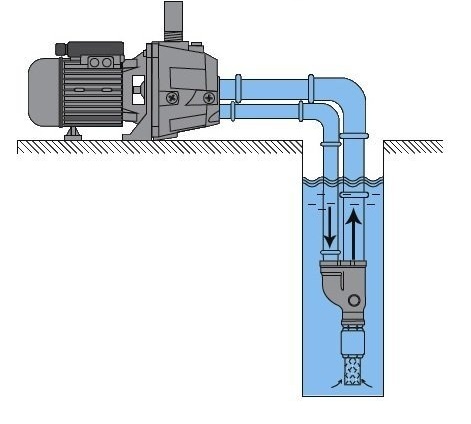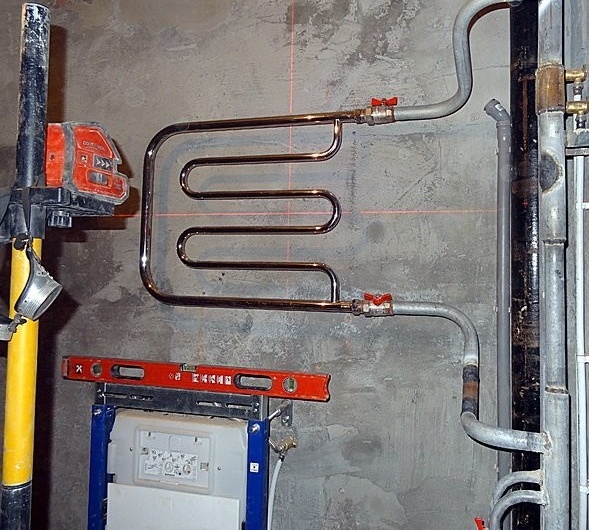Connecting the pumping station to the well: technological features of the work
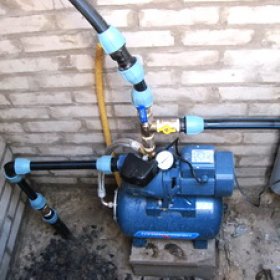
Not always suburban and summer cottages are located near the centralized water supply. If it is not possible to connect to the pipeline, the only way out is the arrangement of an autonomous water supply system. One of its main elements is a pumping station for a well, which you can install and connect with your own hands.
Choosing the right place to install
Installation options can be two: in the utility room in the house or in a specially equipped caisson. The first is considered more convenient in terms of maintenance, since the equipment is easily accessible. For installation of the installation in the building, a heated dry basement or utility room is suitable.
The station should be installed at a small elevation above the floor, so that in case of groundwater the equipment does not fail. Also, you should not lean it against the wall, otherwise the vibration from the working device will be transmitted to the rooms located above.
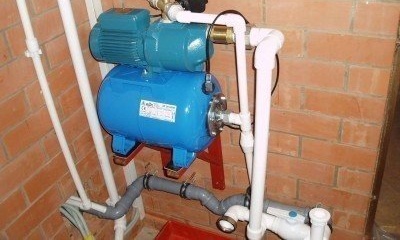
To install a pumping station, choose a heated dry room. It is best to equip a small podium on which the equipment will be mounted.
It should be borne in mind that the building in which the equipment will be installed should be close enough to the well from which the pipeline to the pumping station is laid. The water supply should be laid in the ground below the level of its freezing, otherwise in winter the water may freeze and break pipes. As an option, you can consider the insulation of the pipeline using heat-insulating materials or a heating cable.
Mounting the device in a caisson is a less common solution. The sealed container in which the structure is installed is buried in the soil below the freezing level. It is at this depth that the pumping station should be located. The caisson is insulated as much as possible so that in the most severe frosts the water does not freeze and does not destroy the equipment.
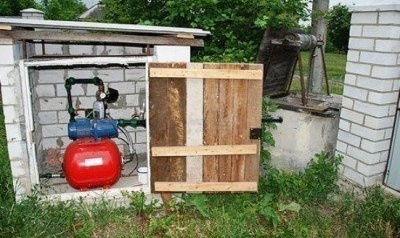
Another option for installing a pumping station. The equipment can be mounted in a specially prepared insulated box located near the well
In addition to installing a pumping station, it is necessary to carry out installation of a water supply system. How to do this, read our next article:https://aquatech.tomathouse.com/en/santehnika/snaruzhj/vodoprovod-v-chastnom-dome-svoimi-rukami.html.
Design features of the device
Before connecting the pumping station to the well, it’s worth at least in general terms to get acquainted with its device. The structural elements of the installation necessarily include a hydraulic accumulator, a self-priming pump, a pressure gauge, pressure switch and connecting fittings. The device of the pump is also simple, it consists of three main parts: the pump part, the electric motor and the ejector, which creates additional vacuum in the pipeline, which allows to increase the water pressure.
Accumulator, which is a container with a plastic membrane, equipped with a pneumatic valve for pumping air. The equipment is necessary to create and maintain pressure in the pipeline, which ensures a normal fluid flow at all points of the drawdown. The liquid supply in the tank makes it possible to use water for some time even in the event of a power outage. The device is equipped with a pressure gauge that allows you to monitor the level of pressure in the system.
Each pump station is equipped with a non-return valve, which significantly increases the performance and safety of the pump. In addition, the equipment has an inlet filter to prevent contamination of the system. The unconditional “advantage” of the design can be considered the possibility of self-dismantling and cleaning the filter, which significantly saves time and money of the station owner.
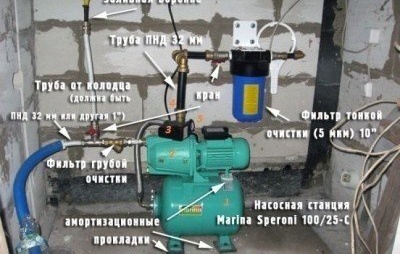
The scheme of the pumping station. The structural elements of the station itself include: 1 - a hydraulic accumulator, 2 - a self-priming pump, 3 - a pressure switch, 4 - a connecting fitting and 5 - a pressure gauge
The system operates as follows. The pump pumps water into the tank, as soon as it is full, the relay switches off the station, which goes into standby mode. At this time, taps open at the draw-off points and water flows to consumers. As soon as the pressure drops to the minimum, the relay switches on the pump and the cycle repeats. Circulating fluid is responsible for cooling the motor. If it is still overheated, the automatics will turn it off and on again only after it has cooled sufficiently.
When choosing a pumping station, you need to know not only its design, but also several important parameters, which you will learn more about in our article:https://aquatech.tomathouse.com/en/vodosnab/nasos/nasos-stancii/kak-vybrat-nasosnuyu-stanciyu-dlya-doma-i-dachi-poleznye-sovety.html.
Installation and connection of the system
There are two exits on the pump station housing. One of them is designed to be connected to the well, and the second to the water supply system of the building. We start from the first. We need a polyethylene pipe of suitable diameter. Its length should be sufficient to lay it to the well and lower it down. A coarse filter, an ordinary metal mesh, and a check valve are attached to one end of the pipe. It is necessary so that the device is always filled with water, which allows you to maintain the pump. After which the part is immersed in the well.
The free end of the pipe must be connected to the pump. It is recommended to do this through a non-return valve that prevents water from pouring out of the system. Thus, one device will be placed at one end of the pipe, the other at the other. However, as practice shows, you can do with only one valve located in the well. We fix a crane at the outlet of the pumping station, which will make it possible to shut off the water if necessary, and we fasten the pipe to it.
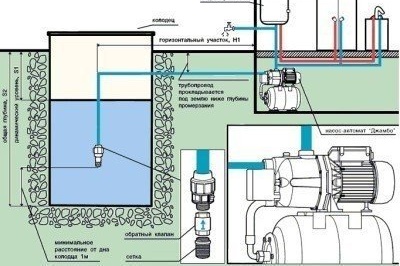
Connection diagram of a pumping station for a well. One output of the equipment is connected to the insulated pipeline leading to the well, the second to the indoor water supply
The second output of the pumping station, usually located on top of the housing, is connected to the water supply system. To do this, we attach a tap to the thread of the device, we twist a polypropylene sleeve onto it. We solder a water pipe to it. We check all the connections again. Threaded not only tighten, but also tighten. Pour water into the equipment through a special hole. The system is ready to go.
As experience shows, pump station installation the well may well be carried out independently. To do this, you will need to carefully read the recommendations of the equipment manufacturer and carry out the installation, carefully following all the instructions. A properly installed system will safely provide the house with clean water.

